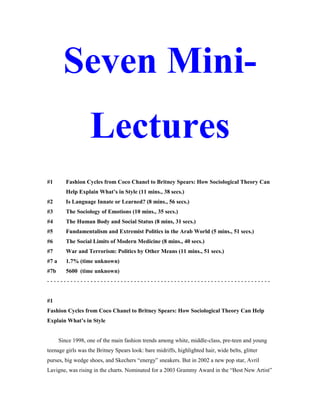The document summarizes seven mini-lectures covering various sociological topics including fashion cycles, language acquisition, the sociology of emotions, social status and the human body, and conflict in the Arab world. It explores how different sociological theories, such as functionalism, conflict theory, and feminism, explain the evolution of fashion trends and the role of language as both an innate and learned behavior influenced by social environments. Notably, it discusses the implications of these theories on identity and social status, while also addressing how fashion and language can reflect and influence social dynamics.

![category, the 17-year-old skater-punk from the small town of Napanee in eastern Ontario, affects
a shaggy, unkempt look. She sports worn-out T-shirts, 70s-style plaid Western shirts with snaps,
low-rise blue jeans, baggy pants, undershirts, a tie, a backpack, a chain wallet, and, for shoes,
Converse Chuck Taylors. The style is similar to the Grunge look of the early 90s, when Nirvana
and Pearl Jam were the big stars on MTV and Kurt Cobain was king. Thanks largely to Avril
Lavigne, the Wall Street Journal announced in December 2002 that Grunge might be back.
Why in late 2002 were the glamorous trends of the pop era possibly giving way in one
market segment to “neo-Grunge?” Why, in general, do fashion shifts take place? In the next few
minutes I’m going to illustrate how the major theoretical approaches in sociology –
functionalism, conflict theory, symbolic interactionism, and feminism – can help explain fashion
cycles. Clothing styles come and go. Many of us are influenced by them. Why does this happen?
Until the 1960s, the standard sociological approach to explaining the ebb and flow of fashion
trends was functionalist. In the functionalist view, fashion trends worked like this. Every season,
exclusive fashion houses in Paris and, to a lesser extent, Milan, New York, and London would
show new styles. Some of the new styles would catch on among the exclusive clientele of Chanel,
Dior, Givenchy, and other big-name designers. The main appeal of expensive new fashions was
that, by wearing them, wealthy clients could distinguish themselves from people who were less
well off. Thus, fashion performed an important social function. By allowing people of different
rank to distinguish themselves from one another, fashion helped to preserve the ordered layering
of society into classes. (“It is an interesting question,” wrote 19th
century American writer Henry
David Thoreau in Walden, “how far [people] would retain their relative rank if they were divested
of their clothes.”) Especially by the 20th
century, thanks to technological advances in clothes
manufacturing, it didn’t take long for inexpensive knockoffs to reach the market and trickle down
to lower classes. New styles then had to be introduced frequently so fashion could continue to
perform its function of helping to maintain an orderly class system. Hence the ebb and flow of
fashion.
The functionalist theory was a fairly accurate account of the way fashion trends worked until
the 1960s. Then, fashion became more democratic. Paris, Milan, New York, and London are still
hugely important fashion centers. However, new fashion trends are increasingly initiated by
lower classes, minority racial and ethnic groups, and people who spurn “high” fashion altogether.
Napanee is, after all, pretty far from Paris, and today big-name designers are much more likely to
be influenced by the inner-city styles of hip-hop than vice-versa. New fashions no longer just
trickle down from upper classes and a few high-fashion centers. Upper classes are nearly as likely](https://image.slidesharecdn.com/lectures-170626151915/85/Lectures-2-320.jpg)























